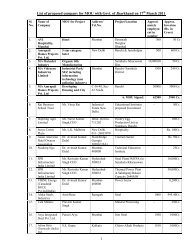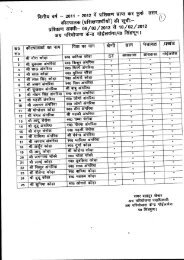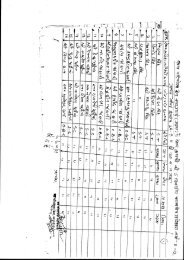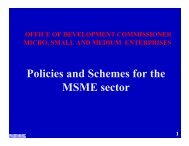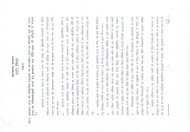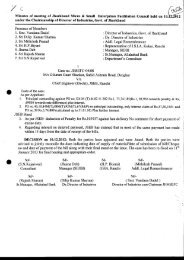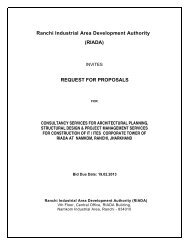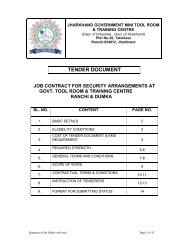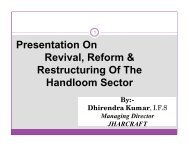Praveen Ranjan AGM RBI, Ranchi - Department of Industry ...
Praveen Ranjan AGM RBI, Ranchi - Department of Industry ...
Praveen Ranjan AGM RBI, Ranchi - Department of Industry ...
Create successful ePaper yourself
Turn your PDF publications into a flip-book with our unique Google optimized e-Paper software.
<strong>Praveen</strong> <strong>Ranjan</strong><br />
<strong>AGM</strong><br />
<strong>RBI</strong>, <strong>Ranchi</strong><br />
Reserve bank <strong>of</strong> India, <strong>Ranchi</strong>
Structure <strong>of</strong> presentation<br />
• Restructuring and asset classification<br />
• Rehabilitation <strong>of</strong> sick units<br />
Reserve bank <strong>of</strong> India, <strong>Ranchi</strong>
Asset classification ‐ MSME<br />
Standard assets<br />
Micro and Small – 0.25% <strong>of</strong> the loan amount.<br />
Medium – 0.40% .<br />
SubStandard Assets<br />
Secured – 15%<br />
Unsecured – 25%<br />
Doubtful – 100% for unsecured portion. 25‐40 for<br />
secured portion<br />
Reserve bank <strong>of</strong> India, <strong>Ranchi</strong>
Restructuring guidelines<br />
• On August 27, 2008, comprehensive guidelines on<br />
Restructuring issued. Current guidelines on<br />
restructuring have been consolidated vide Master<br />
Circular – Income recognition and asset classification<br />
norms – July 1, 2012.<br />
• The current circular harmonizes prudential norms<br />
across all categories <strong>of</strong> restructuring i.e corporate,<br />
retail, SME, infrastructure.<br />
Reserve bank <strong>of</strong> India, <strong>Ranchi</strong>
General Principles<br />
(a) Banks may restructure Accounts classified as<br />
Standard/Sub‐standard/Doubtful. Loss Assets<br />
cannot be restructured.<br />
(b) restructuring/rescheduling retrospectively is not<br />
allowed.<br />
(c) Asset classification status on date <strong>of</strong> approval,<br />
relevant for deciding a.c. after restructuring<br />
(d) Formal consent/application <strong>of</strong> debtor<br />
Reserve bank <strong>of</strong> India, <strong>Ranchi</strong>
(e) Viability should be established<br />
(f) Borrowers indulging in frauds/malfeasance ineligible<br />
for restructuring<br />
(g) BIFR cases ineligible unless BIFR approves<br />
Reserve bank <strong>of</strong> India, <strong>Ranchi</strong>
Asset Classification upon<br />
restructuring<br />
(a) Accounts classified ‘Standard’ be classified ‘Sub‐<br />
Standard’ upon restructuring<br />
(b) NPA, upon restructuring would slip into lower<br />
category. with reference to pre‐restructuring<br />
repayment schedule<br />
(c) All restructured accounts classified NPA eligible for<br />
upgradation to standard after ‘satisfactory<br />
performance’ during ‘specified period’. period. If no S.P. a.c.<br />
by pre‐restructuring repayment schedule.<br />
Reserve bank <strong>of</strong> India, <strong>Ranchi</strong>
(d) Any additional finance can be treated as standard<br />
upto end <strong>of</strong> specified period.<br />
Reserve bank <strong>of</strong> India, <strong>Ranchi</strong>
Provisioning Norms<br />
(a) Restructured Standard advances –2% for first<br />
two years<br />
(b) Restructured t NPA –as per normal provisioning ii i<br />
norms<br />
(c) Restructured NPA after upgradation to standard<br />
–2% in the first year.<br />
(d) Provision for erosion in fair value <strong>of</strong> advance<br />
Reserve bank <strong>of</strong> India, <strong>Ranchi</strong>
Special Asset Classification Status<br />
• package implemented within 90 days <strong>of</strong> approval –<br />
• Upon restructuring, standard will not be downgraded to<br />
SS S.S. and S.S./Doubtful S will not deteriorate, if SP is seen<br />
during specified period, provided<br />
• Dues to bank are fully secured by tangible security,<br />
except SSI borrowers with o/s upto Rs.25 lakhs and<br />
infrastructure<br />
• Unit, if infrastructure, becomes viable in ten years and<br />
others in seven years<br />
Reserve bank <strong>of</strong> India, <strong>Ranchi</strong>
• Repayment period, including moratorium not to<br />
exceed 15 years in case <strong>of</strong> infrastructure and 10 years<br />
in case <strong>of</strong> others.<br />
• Promoters sacrifice/additional funds should be<br />
minimum 15% <strong>of</strong> banks sacrifice – 50% upfront and<br />
15% within ihi a period <strong>of</strong> one year.<br />
• Personal guarantee by promoter except when unit<br />
faces external factors<br />
• Restructuring is not a repeat Restructuring.<br />
Reserve bank <strong>of</strong> India, <strong>Ranchi</strong>
Restructuring <strong>of</strong> SME under Consortium<br />
financing‐Multiple Banking<br />
• Simple Mechanism<br />
• Board approved policy for restructuring <strong>of</strong> SMEs<br />
• Bank with the largest exposure to work out<br />
restructuring package along with the second largest<br />
bank<br />
• Implementation within 90 days <strong>of</strong> receipt <strong>of</strong> requests.<br />
• To keep the board informed<br />
Reserve bank <strong>of</strong> India, <strong>Ranchi</strong>
Rehabilitation <strong>of</strong> Sick Units<br />
• Restructuring if properly implemented would prevent<br />
a unit from turning sick.<br />
• A unit is considered d as sick ik when any <strong>of</strong> the borrowal<br />
accounts <strong>of</strong> the unit remains substandard for more<br />
than 6 months, or<br />
• there is erosion in the net worth due to accumulated<br />
cash losses to the extent <strong>of</strong> 50% <strong>of</strong> its net worth during<br />
the previous accounting year and the unit has been in<br />
commercial production for at least two years.<br />
Reserve bank <strong>of</strong> India, <strong>Ranchi</strong>
• Comprehensive Guidelines for rehabilitation <strong>of</strong> sick<br />
units – January 16, 2002<br />
• Warning signals for sickness ik –<br />
a) Continuous irregularities in cash credit/overdraft<br />
accounts such as inability to maintain stipulated<br />
margin on continuous basis or drawings frequently<br />
exceeding sanctioned limits, periodical interest<br />
remaining unrealized;<br />
b) Outstanding balance in cash credit account<br />
remaining i continuously at the maximum;<br />
Reserve bank <strong>of</strong> India, <strong>Ranchi</strong>
c) Failure to make timely payment <strong>of</strong> installments <strong>of</strong><br />
principal and interest on term loans;<br />
d) Complaints from suppliers <strong>of</strong> raw materials, il water,<br />
power, etc. about non‐ payment <strong>of</strong> bills;<br />
e) Non‐submission or undue delay in submission or<br />
submission <strong>of</strong> incorrect stock statements and other<br />
control statements;<br />
f) Attempts to divert sale proceeds through accounts<br />
with other banks;<br />
Reserve bank <strong>of</strong> India, <strong>Ranchi</strong>
g) Downward trend in credit summations;<br />
h) Frequent return <strong>of</strong> cheques or bills;<br />
i) Steep decline in production figures;<br />
j) Downward trends in sales and fall in pr<strong>of</strong>its;<br />
k) Rising level <strong>of</strong> inventories, which may include large<br />
proportion <strong>of</strong> slow or non‐moving items;<br />
l) Delay in meeting commitments t towards payment <strong>of</strong><br />
installments due, crystallized liabilities under LC/BGs,<br />
etc.<br />
Reserve bank <strong>of</strong> India, <strong>Ranchi</strong>
Liberalisation <strong>of</strong> rehabilitation<br />
<strong>of</strong> SMEs<br />
• January 16, 2002 guidelines withdrawn vide September<br />
12, 2011 circular<br />
• Banks given complete freedom to formulate policy<br />
regarding rehabilitation <strong>of</strong> sick units<br />
• Rehabilitation Policy to be approved by Board <strong>of</strong> the<br />
bank<br />
• Freedom given so as to increase the support provided<br />
to SME sector<br />
Reserve bank <strong>of</strong> India, <strong>Ranchi</strong>
Discretionary concessions<br />
• Waiver <strong>of</strong> interest dues on cash credit and term loans<br />
• Reduction <strong>of</strong> interest – below base rate allowed<br />
• Funding <strong>of</strong> interest due to bank for some time<br />
• Concessional interest on working capital<br />
• Contingency loan assistance<br />
• Funding for start up expenses and margin for working<br />
capital<br />
• 50% <strong>of</strong> promoters contribution to be brought upfront<br />
and rest within one year<br />
Reserve bank <strong>of</strong> India, <strong>Ranchi</strong>
Important Points<br />
• Rehabilitation/restructuring not a matter <strong>of</strong> right<br />
• Banks to exercise their commercial judgement<br />
• Banks to consider viabilty <strong>of</strong> units<br />
• Sacrifices to be decided by banks as per their<br />
commercial il judgement.<br />
• If not found viable –exit routes through SARFAESI<br />
Reserve bank <strong>of</strong> India, <strong>Ranchi</strong>
Data on Sick units ‐ Major Banks<br />
Jharkhand (September 2011)<br />
Bank Group<br />
No. <strong>of</strong> Units<br />
Amount Outstanding<br />
( In Rs. lakhs)<br />
SBI 623 906.32<br />
BOI 0 0<br />
PNB 316 1884<br />
Canara Bank 1 426<br />
JGB 148 159<br />
VGB 0 0<br />
Total <strong>of</strong> all banks 1115 4124.08<br />
Reserve bank <strong>of</strong> India, <strong>Ranchi</strong>
Thank You<br />
Reserve bank <strong>of</strong> India, <strong>Ranchi</strong>



